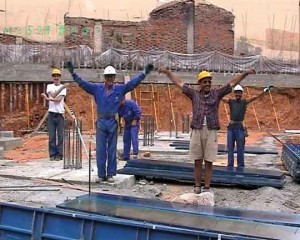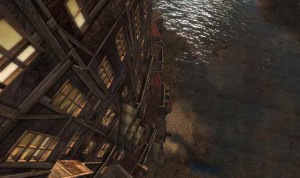« Features
Video Art Now: Real, Virtual, and Machinima
The digital display attached to the existing network technologies facilitates new opportunities for visual creation. In addition to real and virtual video art, new forms incorporate the category of machinima.
By Cristina García-Lasuén
Visual creations today arise from a challenging technological, cultural, and formal mix, and reflect our early twenty-first century society. As such, these visual expressions contribute to the existence of new forms of video art, enabling us to make a threefold classification that takes into account two elements: the technique used and the degree of virtual immersion obtained with each technique.
These two distinguishing factors can be applied in all manifestations, even in works that mix categories producing hybrid images. We could therefore distinguish the following three categories in current video art: real, virtual and machinima.
REAL
It’s not farfetched to affirm that most videos commonly depart from reality, as we can observe from exhibitions in museums and other related art institutions. These analogical images are recorded in real life and portray performances of artists or creative interpretations of certain places or environments, leveraging existing media creation tools. Consider, for example, Bill Viola, Anri Sala, Kaoru Katayama, Peter Greenaway, and Shirin Neshat, among others: their creations either maintain the traditional structure or are combined with multimedia elements.
At other times, the scenes are photographed successively using stop-motion, which adds an animation look to it, a technique used by current artists to make their artistic statements. Blu uses a kind of video graffiti to explain his paintings on the walls of the city; in the video Muto, he starts drawing a brick on a wall that begins to fall and parietal images come alive in sequences that scroll throughout the wall, adopting different biological forms and taking over the urban scene.
It is clear that the current situation of nomadic and global experience provides new perspectives related to storytelling and fictionalized documentary.
VIRTUAL
In a second level of virtual immersion and using a different technique, video uses virtual 3D computer generated imagery (CGI) animation drawings as a base.
Flat animation based on 2D drawings has been developed since early last century; now the novelty is that the development and perfection has been achieved with the latest techniques for creating three-dimensional drawing elements that have volume and can generate a virtual space. The process consists of making a model of each element and character by using an almost sculptural technique, or getting them already finished and then shooting the three-dimensional space.
Depending on if you want to convey a more or less mimetic look of reality, the three-dimensional drawings may look like cartoons or, by contrast, display images so real that could be confused with real photographs. The theme plays, if it were not for fantasy, impossible situations in our world. In this case the viewer observes a striking image that seems to exist in an intermediate space located between reality and fiction.
Thus, Jorge Seva aka Alex Román in The Third & The Seventh film makes an allegory of the third and seventh of the arts, featuring scenes under a slowed time that remains suspended, allowing us to discover unusual details. However, it incorporates a visual narrative in such a natural way that it displaces our senses by creating spatial confusion. Tom Jantol also uses a technique he calls anymation, which mixes animation and virtual images, creating odd-looking videos that allow him to convey his message visually and conceptually with great effect. And, as a last example, we may cite Shane Acker, who heralded a new kind of aesthetics and style of animation with the short 9, which shows the first rag doll image, which he later on turned into a film co-directed with Tim Burton.
MACHINIMA
This third type of video uses the most recent audiovisual techniques that allow the highest degree of virtual immersion. The name relates to the techniques used: machine + animation + cinema.
Machinima is then a real-time film produced within the virtual worlds of video games. Peter Greenaway, who has long proclaimed the death of traditional film and its replacement by immersive multimedia artistic expression, in a public letter to the virtual world users, describes the virtual universe as “a very sophisticated tool that combines traditions of painting with cinema and the graphic arts in present tense terms that permits visual expression of language like never before.” (Schumann)
The world appearing in machinima films was described in Snow Crash (1992), a novel written by Neal Stephenson, which addresses an immersive environment in cyberspace called metaverse. This place is located in a dimension different than reality and populated by avatars that reside in a virtual space that is neither real nor tangible nor a cartoon world.
The virtual world immersion occurs immediately because we enter into space with three-dimensional forms that exist; that is, a space that has volume and casts shadows. The feeling of being inside is reinforced because it allows us to interact in a natural manner with objects and characters of the virtual world, creating situations and scenes that can be recorded live by the machinima.
The importance of this artistic practice is that the volume is not a mere visual impression, but that everything that the machinima shows occupies a place and has been sculpted, piece by piece, by an artist or, in some cases, by aficionados. Moreover, as the figures that are made do not have to submit to earthly physical limits– for example, the law of gravity– surreal and fantastic structures and objectives are achieved that are impossible to find in real life.
Because performance runs in an unreal virtual space, most environments are nurtured by a futuristic aesthetics that take up a feeling of disenchantment for lost utopia from science fiction. In these cases, virtually embodied space is bleak, almost monochromatic and disturbing, as is the case of Bryn Oh and Igor Ballyhoo. However, other creators have decided to retrieve the color that had been moderated in a previous post-conceptual stage and create objects with sensual shapes of bright chrome, as Elros Tuominen aka Antonio Alza and Soror Nishi.
Some symbols and allegories refer to the iconic great public observer reflected in a number, or a huge eye that observes everything. Robot friends, structures, insects, clock gears, and nineteenth century machines are recurring elements that refer to the passage of time since the post-industrial stage, expressing a feeling of closeness and affinity for machines that share most of the virtual artists.
Machinima’s themes are plural and displayed in a kaleidoscopic manner, thus reflecting today’s society. They incorporate arguments that reflect the concerns and interests of our time, expressed in different schools, styles, and genres that have their own conceptual and aesthetic development. In general, this artistic expression experiments with narrative content, whether traditional or new, often more immediate, accessible, and emotive than real video art, but which are addressed in a non-linear, fragmented, and unusual manner and serve to underline this sense of unreality.
The machinima was born in this atmosphere of forms, impressions, and unique situations. Not limited to the goal of recreating a story inworlds and then showing it, the versatility of the medium allows for a wider scope of possibilities and for the creation to be applied to other goals, such as actual movies, preproduction rehearsal, the conception of complex scenes without having to use real actors in the field of advertising, music, television programming, or documentary. Even inside the virtual world there are numerous machinima television programs with deferred transmission, such as Perfect World Productions and Metaverse TV, or, on the contrary, even transmitted live, as Tonight Live with Paisley Beebe, all made expressly to be watched by a loyal audience of hundreds of thousands of avatars worldwide.
Despite this stage of hesitation and experimentation, some machinimatographers have developed a recognizable “house style.” Let us see some of these prominent examples.
Saskia Boddeke aka Rose Borchovski is a multimedia artist who makes video art in several categories. As a virtual artist, Rose develops the story of Susa Bubble, an invention of Rose’s; she fell asleep and woke up twice. To document the history she has built a virtual island or sim, called “The Two Fish,” with different sceneries that reproduce passages from the narration. As she described: “The story of Susa is a sweet but savage story, told in image and text, sound and installation. It is about our dark inside, but also shows how vulnerable and lonely we all can be.” (Schumann)
The detailed universe of Bryn Oh develops stories between humans and robots following steampunk aesthetics. In her film, fantastic characters, shopping carts, mechanical animals, and winding labyrinths appear traversed by a lonely trail of light.
Director Tutsy Navarathna creator of Utopia Island, among others pieces, combines traditional and ancient images inspired in his native oriental India with the innovative international machinima technology.
Osprey Therian is a director who develops visual storytelling without following a particular script. He leaves the camera just filming the space and embarks on a perilous journey through a chaos of metal, as in the case of Igor Ballyhoo’s “Forest of Scissors”, where we are surprised at the harsh environment of cross edges that emerges from the artist’s imagination.
Finally Lainy Voom aka Trace Sanderson, films surreal scenes, sometimes based on other stories and sometimes just letting her imagination go, but always with an identifiable, sober style that disturbingly communicates with a kind of virtualized Magritte. Monkeys, chains, eyes that turn and, above all, time represented in sand or mechanical watches; the characters try to go in the opposite direction observed by the vanitas or any personification of tempus fugit who, laughing in an impeccable evening dress, bankrupts this hope.
INTERACTION, POPULARIZATION AND IMMEDIACY
Everything indicates that we are witnessing an artistic movement that will be common in the near future: interactive, participatory, immediately. A popular art that was born spontaneously outside the traditional art circuits; an artistic expression that relates the film industry with the medium of video, and adds the sound of music and video clips with the spectacular scenes of video games.
This does not replace any other prior artistic practice; in contrast, it adds to other existing audiovisual mediums with its specific multimedia characteristics that reflect the symptoms that define our present time.
This phenomenon of popularization of artistic creation is very recent, but we glimpse the immense possibilities for the future of these expressions that describe a globalized world expressed in a space where there are neither limits nor boundaries. A popular video-movie accessible to everyone and to which we could refer as “Cinemapop.”
WORKS CITED
- Schumann, Simba. “Susa banned by Linden.” Virtual Worlds Magazine. 19 June 2010. Web. November 2010. <http://virtualworldsmagazine.wordpress.com/author/simbaschumann/>
Cristina García-Lasuén is an art critic and curator based in Spain. She is the founder of OPEN THIS END, a cultural organization that researches, develops, and exhibits works of art generated through new technologies. She has collaborated in diverse projects with Beijing World Art Museum (BWAM). She recently curated “OPEN THIS END, Signos de Contemporaneidad” as part of the World Expo 2010 in Shanghai.





































